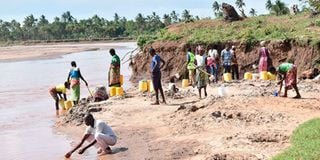Rising burden of neglected tropical diseases sparks alarm

What you need to know:
- Kenya has reported 16 of the 20 listed NTDs.
- Some of the NTDs affecting the population are elephantiasis, bilharzia, intestinal worms, dengue fever, chikungunya, river blindness, rabies and jiggers.
The Ministry of Health has sounded an alarm over the rising burden of Neglected Tropical Diseases (NTDs) in the country. This is even as latest data show that more than 25 million people suffer from NTDs despite Kenya’s efforts to eradicate the illnesses.
Kenya has reported 16 of the 20 listed NTDs. Some of the NTDs affecting the population are elephantiasis, bilharzia, intestinal worms, dengue fever, chikungunya, river blindness, rabies and jiggers.
Speaking recently in Kisumu during celebrations to mark World NTDs Day, Head of Division of Vector Borne and Neglected Tropical Diseases at the Ministry of Health, Dr Wyckliffe Omondi, said the highest burden of NTDs is intestinal worm infections, which affect about 27 counties.
He added that about four million people from the coastal region alone are affected by elephantiasis.
“When we calculate the number of people suffering from NTDs in the 27 counties, it is close to 25 million. Ten million people have bilharzia in 10 counties spread across coastal region, lake region and Western Kenya,” said Dr Omondi.
For trachoma, there are 1.4 million cases spread in arid and semi-arid areas.
He said the diseases have negatively impacted on the productivity of learners, citing social isolation and physical deformities if not treated early.
“NTDs prevent adults from going to work. Some suffer chronic disabilities, impairment, stigma while others live in isolation. For children, worm infection can cause stunted growth and impaired cognitive function besides malnutrition,” he said.
Dr Omondi noted that NTDs flourish in areas with high levels of poverty due to lack of access to clean water and sanitation, adding that the national government is prioritising interventions that are cost-effective and sustainable to eliminate the diseases.
He said there is need to sensitise health workers, strengthen water supply systems and ensure households have access to toilets.
“We are determined to eliminate at least four NTDs by 2027. Already, Kenya is free from the Guinea Worm disease,” he said.
End Fund Vice President Carol Karutu noted that poverty increases the risk of death and disability from NTDs.
“Poor people often experience a delay in seeking treatment due to their economic situation,” said Dr Karutu.
“Trachoma is another disease among the children that can lead to death if not treated early.”
She challenged the county government to invest more on prevention measures of NTDs.
Diseases Prevention and Control advisor at WHO Kenya Joyce Onsongo said across the world over 1 billion are affected by 20 various NTDs.
“NTDs are widespread in the world’s poorest regions where water safety, sanitation and access to health care are less than optimal. NTDs affect over 1 billion people globally and are caused by a variety of pathogens including viruses, bacteria, parasites, fungi, and toxins, “said Dr Onsongo.
She went on: “These diseases are “neglected” because they are almost absent from the global health agenda, receive little funding and are associated with stigma and social exclusion.”
Dr Onsongo said WHO will continue to support the Ministry of Health in all ways possible to make the necessary steps in achieving key milestones towards eliminating NTDs by 2030.
Kisumu Medical Services Executive Gregory Ganda said the county reported 800 cases of bilharzia last year, with more cases going unreported.



